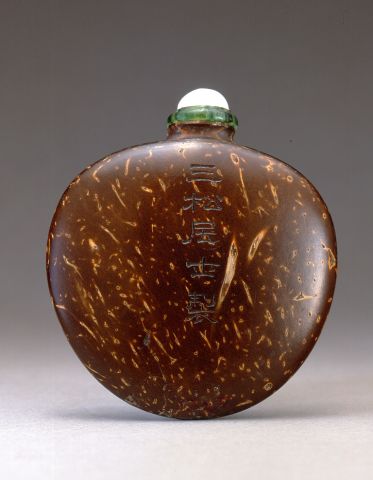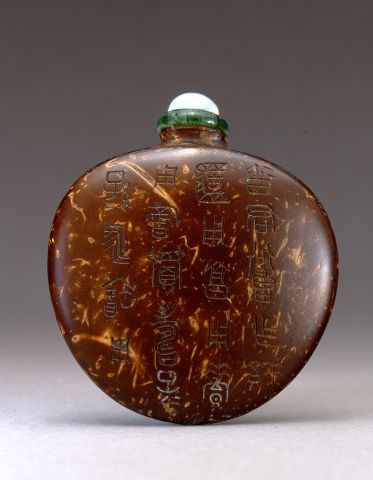

Bottle ID: 380
INCISED INSCRIPTION AND SIGNATURE
Date: 1790-1832
Height: 56 mm
Coconut shell, well flecked with paler markings in a dark chocolate-brown material, of flattened circular form made up of two pieces of coconut, broadened at the narrow sides and over the shoulders with further inset segments tapering into a flared neck, incised on one side with an inscription in archaic bronze script and on the other with the makers name: Sansong Jushi zhi - “Made by the Three-Pines Sage’.
Attributed to Liang Yuanchong, Guangdong Province.
Similar Examples:
Crane Collection no. 506.
Holden, Rachelle R. Rivers and Mountains Far From the World - The Rachelle R. Holden Collection, 1994, pp. 316-317, no. 140.
Kleiner, Robert. Chinese Snuff Bottles - The White Wings Collection, 1997, p. 233, no. 163.
Moss, Hugh, Victor Graham and Ka Bo Tsang. A Treasury of Chinese Snuff Bottles - The Mary and George Bloch Collection, 2009, Vol. 7, Part 1, pp. 72-73, no. 1493.
Provenance:
Hugh Moss (HK) Ltd.
Jin Hing Co., Ltd.
Ruth Lewis Collection
Hugh M. Moss Ltd.
Kurt Graf Blucher von Walstatt (Count Blucher)
Hugh M. Moss Ltd.
Published:
Moss, Hugh M. Chinese Snuff Bottles, 1970, p. 44, no. 161.
Moss, Hugh. Snuff Bottles of China, 1971, p. 95, no. 143.
It is unusual for coconut shell bottles, which are normally made in two pieces, to have the addition of segments to broaden the narrow sides, shoulders or neck. In this case, it has been done with extraordinary subtlety allowing the two convex segments to define the bottle at the base, and gradually separating them along the narrow sides to give a deep shoulder and rarely a flared neck. The archaic inscription is taken from an ancient bronze vessel, a subject of intense study among mid-to-late Qing scholars. The signature, Three Pines Sage, is of a documented retired scholar who became a Buddhist (jushi) or sage and was the name adopted by the literatus Liang Yuanchong, (1764-1832) from Shunde in Guangdong province. He was a noted calligrapher and painter who is known to have copied his uncle’s albums of ancient works, which would have included, no doubt, bronze inscriptions such as that found here. The description records the vessel, who made it, and expresses the wish that it be treasured for generations to come by descendants of the owner.
< Back to full list
 English
English 中文
中文